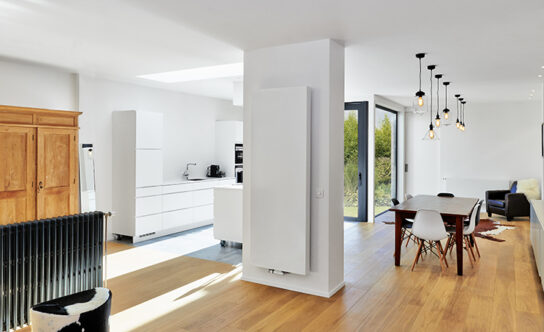Modern heating: the latest radiator designs
Radiators can be divisive things. This may come as a surprise to those among us who pay no heed to the wall-mounted items that warm our homes, but many homeowners go to great expense in removing standard modern models to replace them with antique ones, or ripping out bulky old rads to install streamlined 21st century designs. Vertical models are particularly popular at the moment, as are ones that come in different colours and finishes. These are often labelled as ‘designer radiators’ by the suppliers and DIY superstores, with brands such as Bisque or Quinn both being popular.
The materials used and technology involved can make radiators expensive things to buy and install. So what are the differences and which of the modern models are the ones for you?

Firstly we need to talk about how your radiators are powered. A lot of the most modern radiators are powered by electricity and are independent of any boiler-linked gas central heating system. This means that you can easily add radiators without extra plumbing work, but there’s also the problem that electricity can be expensive when it comes to running heating.
As there are generally no pipes or water to plumb into the radiator, these new electric models can be slimline and fit in odd spaces where you wouldn’t normally place a radiator. All you need is a plug socket in some cases, as many don’t even have to be permanently connected up to your electricity supply.
The latest trend in electric radiators is glass radiators, which are very efficient slender pieces of glass (with designs on) that work like a large heated windscreen, transferring warmth into the room. No oil or water comes through the radiator, meaning that maintenance costs are cut to almost nothing. That said, be wary that you’ll find fewer experts that deal with these newer radiators should something go wrong.
Most people looking for newer radiators will already have a central heating system in place and will simply be looking for something that fits in with this, whether they are replacing their radiators for aesthetic reasons or because their tradesperson has suggested that old radiators need to be replaced due to corrosion or age.

If you’re in the buying frame of mind, the first thing to think about is materials. This will impact on cost, but also on weight and how quickly your radiator warms up. Aluminium is the most effective, although iron and steel models will give a different look. Reproduction antique radiators may often be steel, with reconditioned ones being iron.
The next question is one of how your radiator works and how many panels it has. A single panel radiator may fit in slender spaces and look nicer, but there is little doubt that a double panel model will keep you warmer. Convection fins will also help. These are the zig-zag metal fins that usually sit between two panels on a standard double panel model. A double panel radiator with convection is likely to give you most heat for your money. Many more modern radiators do away with this efficiency so that they can retain their streamlined look.
Modern designer radiators vary hugely in terms of price. A standard steel single panel radiator comes in at around £50, whereas something designer starts at around £80 and can go up to almost £1,000. The job they do will be much the same (the BTU value they boast will tell you how much warmth they will push out), you just need to ask whether them being easier on the eye is worth it. Some are certainly very attractive and can even be a focal point in a modernist home.
Technically, these modern plumbed-in models will work in an almost identical way to your standard radiator from the local plumbing supplies shop. They will need to be bled and valved in the same way, although the bleeding valve may look different and be in a different spot. Many modern models, which can look more like towel rails, do away with the need for radiator keys and are instead bled by opening the valves with flat-headed screwdrivers.
Looking to replace your radiators? Find a heating engineer to help.




Indeed, German electric radiators are now available in new designs or models. Also, I think a slimline radiator is one of those kinds that would best fit any part of the house. Thanks for this great post, by the way!